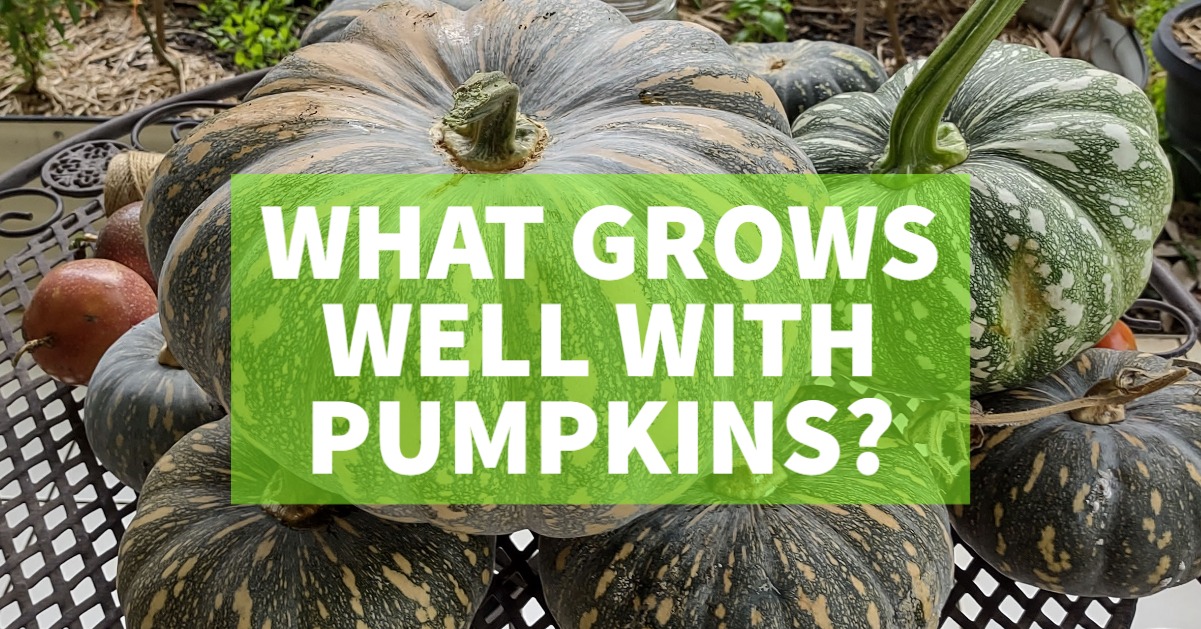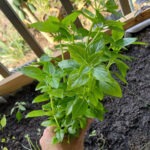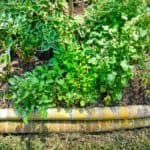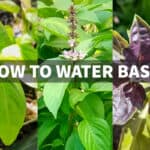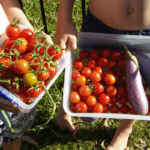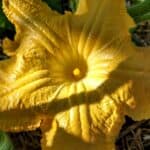This post may contain affiliate links.
Pumpkins are easy to grow and can give you a huge volume of food. But what grows well with pumpkins? What can you plant near pumpkins that will help them grow better? Are there plants that will not be happy near pumpkins and do pumpkins actually have any companion plants? Will pumpkins choke other tropical vegetables?

In companion planting, both plants help each other in some way and do not compete or hinder each other’s growth. Everyone knows that basil and marigolds are good companion plants for tomatoes for instance, but what about pumpkins? What can you plant with pumpkins to maximise space, food production, pest resistance, nutrients and yield?
What grows well with pumpkins? List.
- Sunflowers
- Corn
- Climbing Beans (Runner beans, pole beans, snake beans)
- Marigolds (Dwarf or African tagetes)
- Lavender
- Marjoram
- Oregano
- Papayas (Pawpaw in Australia)
- Thai basil
- Chives
- Cone flowers (Echinacea purpurea)
- Nasturtiums
See below for information on why these plants can be planted with pumpkins and why they grow well with pumpkins.
Pumpkins grow in the tropics easily, but, or course, you can grow pumpkins in just about all climates. Your growing season will depend on where you are, but in the tropics, we can grow and sew pumpkins year-round, depending on the variety.
The quality of your soil will also affect your ability to grow pumpkins, and all plants. Most plants prefer good soil rich with organic matter and nutrients, that holds water but doesn’t become too wet. There are a few exceptions of course! Pumpkins like good, rich, soil. But if you don’t have that, add some well rotted manure of compost, mulch it, and try to grow them. You may be surprised!
Wanter pumpkins when the soil is starting to become dry. Aim for continuously moist soil, water deep, not just the surface. A pumpkin plant’s roots are shallow, but still, you want the soil moist to a good depth.
Pumpkin vines can and do throw out extra roots along their length if they touch the ground. This means you need to water the whole area, not just where you planted the original pumpkin seed or plant. Try not to let pumpkin leaves sit wet, as this can encourage mould, fungus, and disease.
Pumpkin vines bear male and female flowers separately. If you need to find out what the male and female flowers look like, and how to pollinate them by hand, you need to see the photos and information in our post, link in the previous paragraph.
You can grow seeds from store-bought pumpkins, but the different types of pumpkins and gourds have a tendency to cross-pollinate. Your seeds may, possibly, not breed true.
I personally grow Japanese pumpkins year-round and the plants can last more than one year. You can grow pumpkins in the ground or in raised beds, but you’ll need to manage their huge growth and spread in a container, pot, or raised bed.
Be sure to keep your ripening pumpkins off the ground. A pumpkin sitting on wet soil can rot. We use straw or some non-toxic dry mulch for this.
There are many varieties of pumpkins, gourds, and squash that you can try growing, for food or for ornamentation. These plants belong to the cucurbit family.
Why You Need to Grow Plants With Pumpkins
A monoculture is never a good idea. A squash bug will find his perfect habitat if he arrives in a garden bed full of pumpkins. He will invite his wife, friends, and start a large family at your pumpkins’ expense!
Instead of a monoculture, co-plant with good companion plants, grow a variety of plants together to confuse bugs, attract pollinators, cover the ground, attract beneficial insects that prey on pest species, provide support and shade, living mulch and green mulch for chop and drop.
You should always be covering your soil, with mulch or plants or a man-made barrier. This keeps the soil shaded, traps moisture, decreases wind and rain erosion and enhances your soil’s biome. Pumpkin vines themselves are very good at shielding your soil. Their huge leaves act as umbrellas in heavy rain.
Growing a variety of plants allows you to maximise food and flower production, in succession, adding variety to your harvest and diet and extending your growing season. Even in a small bed or pot, you should, and can, grow a diverse species of plant that help each other out.
Even if you decide not to plant other plants amongst your pumpkins, find a spot in your garden for the flowers that attract vital pollinators and hoverflies to eat aphids, mites, bugs and mealy bugs. Try to encourage birds too, our feathered friends can make a tasty snack out of many pest species. We use guinea fowl to eat pests, without killing our plants. Chickens will likely pull or scratch up young pumpkins, so protect young plants with baskets, boxes, or bird netting.
Of course, you may have to build a high fence or cage if you live somewhere with a lot of pumpkin-eating wildlife. Chickens are our only real problem. Wallabies have never touched our pumpkins, but we do have wallabies in the garden. I don’t know if wallabies eat pumpkin vines, they mostly stick with the grass. We do not have deer.
Oregano
Oregano can be used to cover your soil as a cover crop or living mulch. It’s also a culinary or medicinal herb. Some varieties are very easy to grow in the tropics in good soil with good drainage.
Marjoram
Growing marjoram around pumpkins is said to improve their flavour. These aromatic herbs are great garden additions and their flowers can attract beneficial insects.
Nasturtium
Nasturtium flowers are a good attractor of beneficial insects. Some of the insects they attract feed on pumpkin pests like squash bugs, aphids, and pumpkin beetles. The peppery tasting leaves and flowers can also be eaten and are rich in vitamin C and are considered to have medicinal properties, helping your immune system to fight disease.
Nasturtium plants can become huge and have a tendency to scramble up and through bushes or shrubs. There are various varieties of nasturtium, some are smaller.
If you have slugs where you are, nasturtium plants are thought to attract slugs away from other plants. They can also attract aphids and blackflies.
Marigolds (Tagetes)
Most marigolds will grow well in the tropics and subtropics, pretty much year round, adding bright splashes of orange, red, and yellow to your beds. Not only do they beautify your gardens, but they can also attract beneficial insects like hoverflies. A chemical produced by marigolds is also said to keep soil nematodes away.
So plant marigolds in and near your pumpkins to reap the benefits. Marigolds are edible flowers with potential health benefits. Marigolds can also help repel mosquitoes, as can lemongrass.
Sunflowers
Chives
Chives can be a little soft and small to plant around pumpkins, but their smell can deter cucumber beetles, so that could be an advantage in planting them around pumpkins and cucurbits.
Papayas
Papayas should always be in your garden as they are easy to grow in the tropics (in good soil and a good spot) and provide sweet orange fruit, along with green papaya for fermenting, salads, and curries. Papaya is a tall plant or small tree, bearing its canopy of leaves well above your pumpkin vines giving some mid-day sun protection.
The old leaves are also useful for chop and drop to fertilise and mulch your soil. Papayas are considered to be heavy feeders, so you will need to continuously feed and fertilise your soil for good growth of both pumpkins and papaya. Both plants will need adequate but not excessive water to avoid root rot. For this reason, soil must be rich and drain well.
Adding nitrogen fixers to the pumpkin/papaya combination would be a good thing. Think beans
I’ve grown pumpkins in garden beds below papaya trees for years and the combination has worked well. This allows you to harvest food at many levels in your garden, at once. Grow papayas anywhere you could use some shade and your soil is rich with organic matter.
Thai Basil
Thai basil is incredibly easy to grow in our tropical climate, self-seeding or “volunteering” at will. It will grow as a perennial for several years producing lovely purple-blue flowers constantly. These flowers are loved by many species of bees.
Of all the herbs we grow in the tropics, Thai basil has proven easiest.
The main stems of Thai basil become quite woody, so are strong enough to withstand pressure from pumpkin vines and the plants are taller than the vines on the ground. For these reasons, there is always Thai basil in my tropical pumpkin patch.
Just brushing against this plant produces a wonderful scent making your garden a better place to be. Of course, this plant has many culinary uses, particularly in Southeast Asian food, but you can also substitute it for sweet basil. European sweet basil can be more difficult to grow in the tropics.
Basil plants are also thought to repel flea beetles, these beetles are attracted by radishes, so radishes could be a good sacrificial crop in a nearby bed.
Thai basil is not to be confused with tulsi, holy basil, which we find more difficult to grow. We grow at least 10 species of basil in raised beds, pots, and in the soil.
Growing Pumpkins On Supports or Trellises, Can You Under-Plant?
Pumpkins do like to climb, and will climb up through trees and even over fences. I’ve seen it happen in my own garden, particularly in the tropical wet season (summer) when they can grow really fast. A single pumpkin vine grew up through my grapefruit tree and clear over the fence!
Some gardeners do grow pumpkins vertically, on supports or trellises, particularly the small pumpkin varieties. The very large pumpkins, weighing 5 kg or more, would need a very sturdy support!
If you plan to grow a pumpkin cultivar vertically and want to under-plant, then pick a plant that enjoys some shade and won’t compete heavily with the pumpkin plant for nutrients.
Because your pumpkins will need nitrogen for leafy growth and phosphorous and potassium for fruit and flowers. If you co-plant with a plant that just requires a lot of nitrogen, for instance, you may not get the results you’re looking for.
What Not To Plant With Pumpkins
- Other varieties of squash, gourds, and pumpkin (cucurbits)
- Large root crops like beets and sweet potato
- Small, low growing herbs that could be smothered by the pumpkin’s vigorous and huge growth.
- Heavy feeding and thirsty plants that could compete for nutrients and water.
- Brassicas (cabbage family)
There’s no strong reason not to plant any of the above plants with pumpkins, but it might not be the best idea to do so.
If you grow multiple varieties of pumpkin together, you’ll have a big tangled mess of a bed, the leaves will compete for light, and if you plan to seed save there is a danger of cross-pollination.
Large root crops like beets, large onions, and sweet potatoes may physically occupy the space the pumpkins need for their roots. Pumpkin roots are shallow, so harvesting root crops could easily disturb the pumpkin plant’s root system.
Anything small and low-growing can easily be smothered out by the fast-growing, huge leaves and heavy vines of a mature pumpkin vine. Never underestimate just how big and how long a pumpkin can get!
Because pumpkins can suffer from pests and fungal disease, overcrowding your pumpkin bed isn’t the best idea. A plant that receives good sun, sufficient water, and abundant water will be more disease and pest resistant than a weak plant, so aim for healthy pumpkin plants, but also don’t overcrowd them, allow good air flow to guard against blight and powdery mildew.
Have you found some good plants to grow with pumpkins? Share your successes and failures at pumpkin companion planting in the comments. This is how we grow as gardeners, through experimenting and finding what works and what doesn’t. Never be afraid to try.
